Product Market Link Prediction#
A hidden connection is stronger than an obvious one - Heraclitus
Link prediction in network analysis seeks to infer missing or future connections between nodes based on observed relationships. In the context of product markets, firms are interconnected through shared product similarities and competitive interactions. We construct firm networks from text-based product market similarity data, and explore the application of several link prediction algorithms. Additionally, accuracy metrics such as precision-recall and ROC curves are examined to assess the performance of these predictions.
# By: Terence Lim, 2020-2025 (terence-lim.github.io)
import zipfile
import io
import numpy as np
import pandas as pd
from pandas import DataFrame, Series
from sklearn import metrics
import matplotlib.pyplot as plt
import networkx as nx
from finds.database import SQL, RedisDB
from finds.structured import CRSP, BusDay, PSTAT
from finds.readers import requests_get
from finds.recipes import graph_info
from secret import credentials, paths
# %matplotlib qt
VERBOSE = 0
sql = SQL(**credentials['sql'], verbose=VERBOSE)
bd = BusDay(sql, verbose=VERBOSE)
rdb = RedisDB(**credentials['redis'])
pstat = PSTAT(sql, bd, verbose=VERBOSE)
crsp = CRSP(sql, bd, rdb, verbose=VERBOSE)
Product market linkages#
Hoberg and Phillips (2016) developed a text-based measure of firm similarity by analyzing product descriptions in 10-K filings. Their methodology constructs firm-by-firm similarity scores using word vectors, filtering out common words and focusing on nouns and proper nouns while excluding geographic terms. This approach captures shifts in product markets over time, as revealed by their business descriptions in annual company filings.
The TNIC-3 dataset is calibrated to align with the granularity of three-digit SIC codes, providing a structured industry classification. The TNIC-2 dataset represents a more comprehensive version, including all firm pairs, even those with weak relationships.
Source: Hoberg and Phillips Industry Classification
The TNIC-2 and TNIC-3 datasets are retrieved from the Hoberg and Phillips website.
root = 'https://hobergphillips.tuck.dartmouth.edu/idata/'
tnic_data = {}
for scheme in ['tnic2', 'tnic3']:
source = root + scheme + '_data.zip'
if source.startswith('http'):
response = requests_get(source)
source = io.BytesIO(response.content)
with zipfile.ZipFile(source).open(scheme + "_data.txt") as f:
tnic_data[scheme] = pd.read_csv(f, sep='\s+')
for k,v in tnic_data.items():
print(k, v.shape)
tnic2 (52812348, 4)
tnic3 (27161830, 4)
# extract last year of both tnic schemes, merge in permno, and require in univ
year = max(tnic_data['tnic2']['year'])
capsize = 10 # large cap (large than NYSE median)
univ = crsp.get_universe(bd.endyr(year))
univ = univ[univ['decile'] <= capsize]
lookup = pstat.build_lookup('gvkey', 'lpermno', fillna=0)
nodes = {}
tnic = {}
edges = {}
for scheme in ['tnic2', 'tnic3']:
tnic[scheme] = tnic_data[scheme][tnic_data[scheme].year == year].dropna()
gvkeys = sorted(set(tnic[scheme]['gvkey1']).union(tnic[scheme]['gvkey2']))
df = DataFrame(index=gvkeys, data=lookup(gvkeys), columns=['permno'])
nodes[scheme] = df[df['permno'].gt(0)
& df['permno'].isin(univ.index)].drop_duplicates()
nodes['tnic2'] = nodes['tnic2'][nodes['tnic2'].index.isin(nodes['tnic3'].index)]
nodes['tnic3'] = nodes['tnic3'][nodes['tnic3'].index.isin(nodes['tnic2'].index)]
Using the TNIC-2 and TNIC-3 datasets, undirected graphs are constructed where nodes represent firms and edges indicate product market similarities based on the chosen granularity of the classification schemes.
# create graphs of tnic2 (denser graph) and tnic3 (sparser graph) schemes
for scheme in ['tnic2', 'tnic3']:
e = tnic[scheme][tnic[scheme]['gvkey1'].isin(nodes[scheme].index) &
tnic[scheme]['gvkey2'].isin(nodes[scheme].index)]
edges[scheme] = list(e[['gvkey1', 'gvkey2', 'score']]\
.itertuples(index=False, name=None))
results = {}
G = {}
for (scheme, node), (_, edge) in zip(nodes.items(), edges.items()):
print(scheme, 'nodes =', len(node), 'edges =', len(edge))
# populate graph
g = nx.Graph()
g.add_nodes_from(node.index)
g.add_weighted_edges_from(edge)
# remove self-loops: not necessary
g.remove_edges_from(nx.selfloop_edges(g))
# graph info
results[scheme] = Series(graph_info(g, fast=True))
# Plot degree distribution
fig, ax = plt.subplots(clear=True, figsize=(10, 6))
degree = nx.degree_histogram(g)
degree = DataFrame(data={'degree': degree[1:]}, # exclude degree 0
index=np.arange(1, len(degree)))
degree['bin'] = (degree.index // (2*capsize) + 1) * (2*capsize)
degree.groupby('bin').sum().plot(kind='bar', ax=ax, fontsize=6)
ax.set_title(f'Degree Distribution of {scheme.upper()} links {year}')
plt.tight_layout()
G[scheme] = g
tnic2 nodes = 3296 edges = 819984
tnic3 nodes = 3296 edges = 528012
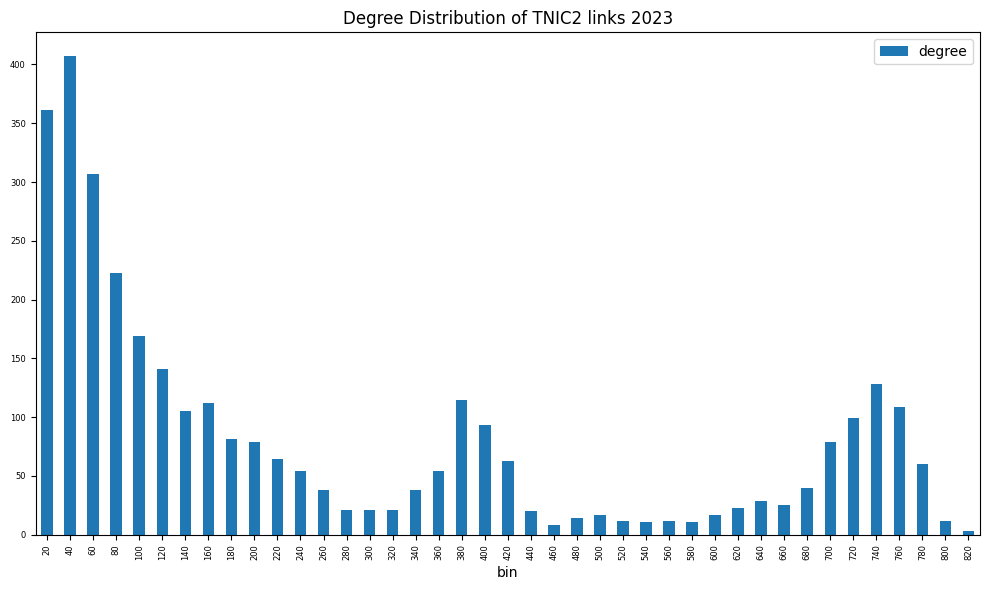
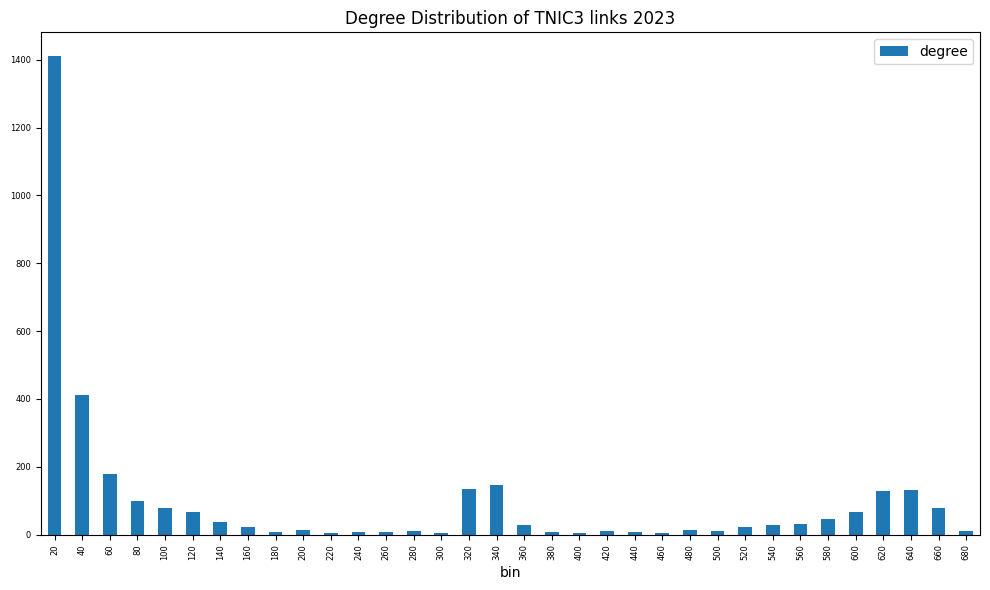
print(f"Graph properties of TNIC schemes {year}")
DataFrame(results)
Graph properties of TNIC schemes 2023
| tnic2 | tnic3 | |
|---|---|---|
| transitivity | 0.834713 | 0.881587 |
| average_clustering | 0.592383 | 0.571318 |
| connected | True | False |
| connected_components | 1 | 25 |
| size_largest_component | 3296 | 3255 |
| directed | False | False |
| weighted | True | True |
| negatively_weighted | False | False |
| edges | 409992 | 264006 |
| nodes | 3296 | 3296 |
| selfloops | 0 | 0 |
| density | 0.075503 | 0.048618 |
Link prediction algorithms#
Link prediction aims to identify missing or future connections between nodes in a network. Given a partially observed network, these algorithms infer which links are most likely to be added or missing based on existing connections and network structure.
Common link prediction algorithms include:
Jaccard Coefficient: Measures the similarity between two nodes by comparing their shared neighbors relative to their total number of neighbors.
Resource Allocation: Assigns a higher likelihood of connection between nodes that share many common neighbors, emphasizing smaller-degree nodes.
Adamic-Adar: Enhances the Resource Allocation approach by weighting common neighbors based on their overall connectivity.
Preferential Attachment: Predicts new links based on the idea that nodes with higher degrees are more likely to form new connections.
# helper to call link prediction algorithms
def link_prediction(G):
"""Predict link scores for all nonexistent edges in graph"""
def links(links):
"""returns list of edge-score 3-tuples sorted by highest score"""
return sorted(links, key=lambda x: x[2], reverse=True)
resource = links(nx.resource_allocation_index(G))
jaccard = links(nx.jaccard_coefficient(G))
adamic = links(nx.adamic_adar_index(G))
preferential = links(nx.preferential_attachment(G))
return {'resource_allocation': resource,
'jaccard_coefficient': jaccard,
'adamic_adar': adamic,
'preferential_attachment': preferential}
links = link_prediction(G['tnic3'])
Accuracy metrics#
Common metrics to assess the accuracy of link prediction (or any binary classification) models:
Precision: The fraction of predicted links that are actual links.
Recall: The fraction of actual links that were correctly predicted.
Accuracy: The overall correctness of predictions.
Confusion Matrix: A summary of prediction outcomes.
F1 Score: A balanced measure between precision and recall, useful for imbalanced datasets. It is calculated as:
where
False Positive (FP): Incorrectly predicted links.
False Negative (FN): Missed actual links.
True Positive (TP): Correctly predicted links.
True Negative (TN): Correctly identified non-links.
ROC Curve#
The Receiver Operating Characteristic (ROC) curve and the Area Under the Curve (AUC) evaluates model performance by measuring the trade-off between true positive and false positive rates at various classification score thresholds.
The ROC curve plots the following metrics on the two axes:
True Positive Rate (TPR) (or Sensitivity) \(= \frac{TP}{TP+FN}\): Measures how many actual positives are correctly identified.
False Positive Rate (FPR) \(= \frac{FP}{FP+TN}\): Measures how many negative cases are incorrectly classified as positive.
The AUC measures the area under the ROC curve and provides a single number to quantify model performance. A higher AUC means the model is better at distinguishing between positive and negative classes.
def make_sample(prediction, edges):
"""helper to extract predicted scores and gold labels"""
names = [e[:2] for e in prediction] # node-pairs of nonexistent edges
scores = [e[-1] for e in prediction] # predicted scores (ordered)
gold = [e[:2] in edges for e in prediction] # gold labels of nonexistent edges
return gold, scores, names # actual, predicted score, names
report = {}
for ifig, (method, pred) in enumerate(links.items()):
# extract predicted scores and gold labels of nonexistent edges
# y, scores, names = make_sample(pred, G['tnic2'].edges)
names = [e[:2] for e in pred] # node-pairs of nonexistent edges
scores = [e[-1] for e in pred] # predicted scores of edge
y = [e[:2] in G['tnic2'].edges for e in pred] # gold labels of nonexistent edges
# plot roc curve
metrics.RocCurveDisplay.from_predictions(y_true=y, y_pred=scores,
plot_chance_level=True)
plt.title(f"ROC Curve: {method}")
plt.tight_layout()
# set classification threshold at class proportion
thresh = scores[sum(y)]
y_pred = [score >= thresh for score in scores]
# generate and plot confusion matrix
cm = metrics.confusion_matrix(y_true=y, y_pred=y_pred, normalize='all')
disp = metrics.ConfusionMatrixDisplay(confusion_matrix=cm)
disp.plot()
plt.title(f"Confusion Matrix: {method}")
plt.tight_layout()
# generate classification report
report[method] = metrics.classification_report(y_true=y, y_pred=y_pred)
print(f"Classification Report: {method}")
print(report[method])
Classification Report: resource_allocation
precision recall f1-score support
False 0.99 0.99 0.99 5020168
True 0.62 0.62 0.62 145986
accuracy 0.98 5166154
macro avg 0.80 0.80 0.80 5166154
weighted avg 0.98 0.98 0.98 5166154
Classification Report: jaccard_coefficient
precision recall f1-score support
False 0.99 0.99 0.99 5020168
True 0.60 0.60 0.60 145986
accuracy 0.98 5166154
macro avg 0.79 0.79 0.79 5166154
weighted avg 0.98 0.98 0.98 5166154
Classification Report: adamic_adar
precision recall f1-score support
False 0.99 0.99 0.99 5020168
True 0.60 0.60 0.60 145986
accuracy 0.98 5166154
macro avg 0.79 0.79 0.79 5166154
weighted avg 0.98 0.98 0.98 5166154
Classification Report: preferential_attachment
precision recall f1-score support
False 0.97 0.97 0.97 5020168
True 0.09 0.09 0.09 145986
accuracy 0.95 5166154
macro avg 0.53 0.53 0.53 5166154
weighted avg 0.95 0.95 0.95 5166154

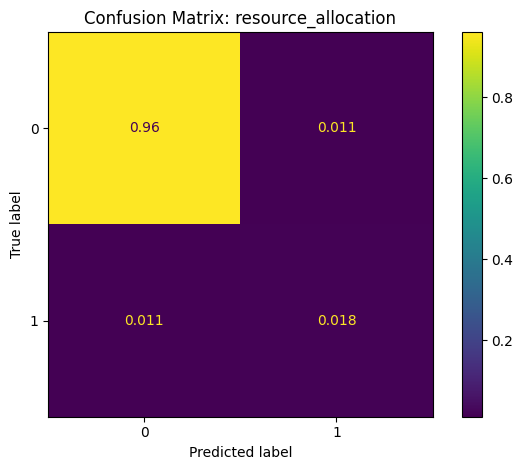
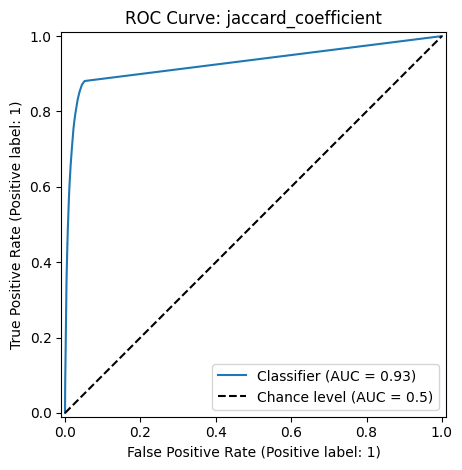
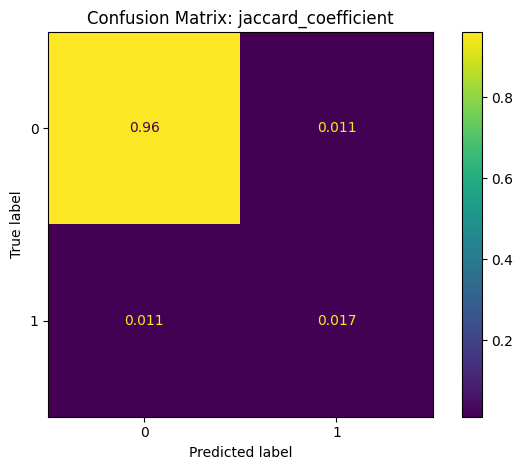
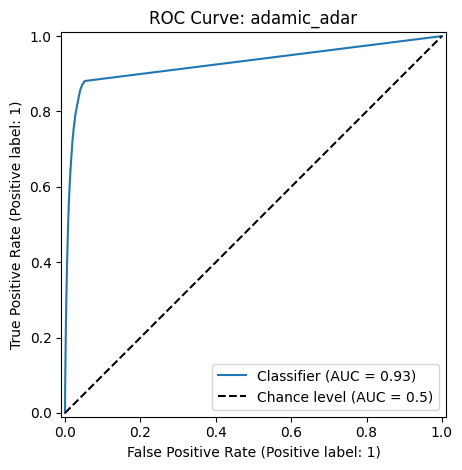
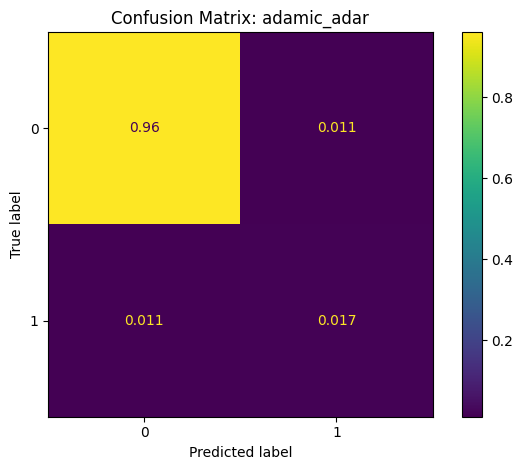
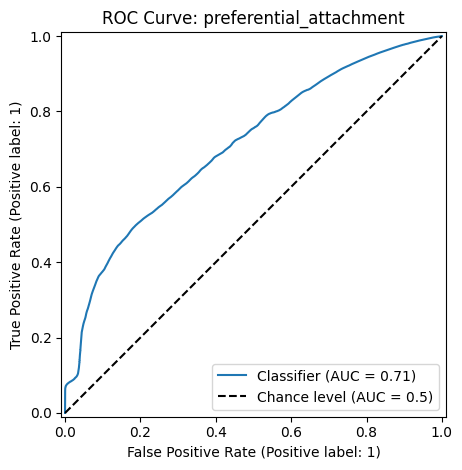
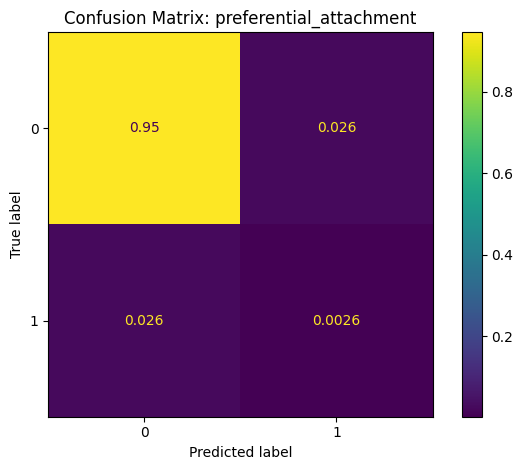
References:
Gerard Hoberg and Gordon Phillips, 2016, Text-Based Network Industries and Endogenous Product Differentiation.Journal of Political Economy 124 (5), 1423-1465.
Gerard Hoberg and Gordon Phillips, 2010, Product Market Synergies and Competition in Mergers and Acquisitions: A Text-Based Analysis. Review of Financial Studies 23 (10), 3773-3811.